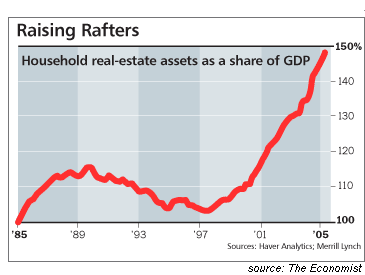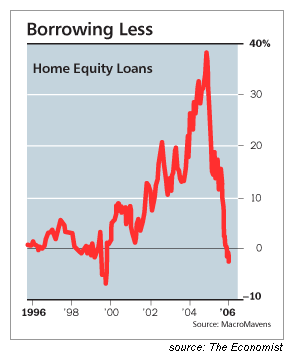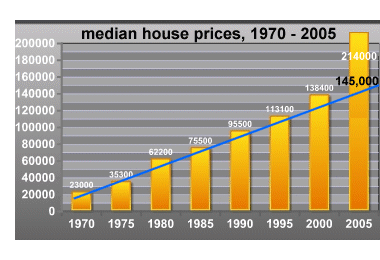Saturday, April 29, 2006
Thursday, April 27, 2006
New homes sales surged

April 27, 2006 -- News: Sale of new homes in April surged 13.8%. This increased the odds that the Fed would boost rates twice more, once on May 10 and then a second boost in June. Strange, on the housing the new home building stocks only budged higher, no big surge. On the housing news, the yield on the bellwether 10 year note rose to a new highs of 5.10%.
I just heard this morning's speech by Fed Chairman Bernanke. Just as I thought, Bernanke is zeroing in on the all-important housing market. Mortgage applications have suddenly plunged. The one thing that is clear is that Bernanke is afraid of ANY slowdown in the US economy. On that basis, Bernanke stated that the Fed is watching economic developments as we go along, and I thought that he even hinted that the Fed may not boost rates at the next meeting which will occur on May 10.
Up to now, another rate increase to 5% on May 10 was a given. Suddenly, Bernanke is saying that nothing is written in stone, that even on the May 10 Fed meeting they may not boost rates.
Let me put it strongly -- the Fed will do almost anything to keep the US economy from slowing. The Fed is mortally afraid of a consumer slowdown, and when you talk about the US consumer you are talking about housing. Housing is now the chief worry of Mr. Bernanke.
Wednesday, April 26, 2006
Housing stocks

There's something bothering the stock market, and I can't but my finger on it. Is it rising interest rates? Maybe. Is it the weakening dollar? Possibly. But if I had to guess I'd guess it's the real estate/home building picture. Home building has been the "big kahuna," the launcher for the consumer-buying frenzy of the last few years.
Here's my thinking. If anything is wrong in home building, I think it would show up first in the action of the big home building stocks. Forget all those lagging statistics on home starts and mortgages applications and defaults, it's the home building giants that I'm watching.
A few weeks ago I noted that the home building stocks had completed a first decline but had then bounced higher. I said that I didn't like the looks of the home builders, but as long as they held above their first decline lows, I could not consider them in trouble. But now the picture might be changing -- but I don't hear anyone talking about it.
I'm showing daily chart of two of the leading home building giants, Ryland Group and Lennar Corp. RYL has declined to just above its preceding low of 64.83. The stock looks ready to top out, and anything below 64.83 will do it.
LEN has already broken under its preceding low at 55.17, and the stock has topped out as far as I'm concerned. These two stocks are typical of most of the stocks in the home building group. If the group is in the process of topping out, I have to think that this is an ominous message for the whole real estate/home building sector. And as this is the area that has bolstered the US consumer buying craze, well, it's something to think about, wouldn't you say?
Late note on the home builders. On news that existing home sales were up slightly in March, today the home building stocks popped higher. We'll see whether this is just a one-day news-related move or whether it's something more fundamental.
Monday, April 24, 2006
Friday, April 21, 2006
Bay Area: population leaving

The bursting technology bubble sent people packing from the San Francisco Bay area. The rate of domestic migration out of the area nearly tripled to an average annual net loss of 14.7 people per 1,000 population, compared with a loss of 5.5 people in the 1990s. At the same time, the Boston area, another high-tech hub, lost workers at an average annual rate of 9.5 domestic residents per 1,000 population, nearly double the '90s rate.
Some economists say the losses of skilled workers, coupled with high housing costs, could hamper the ability of the tech industry to attract new labor, at least in those areas. "Today, housing in both Boston and the Bay area is unaffordable" relative to other parts of the country, says Mark Zandi, chief economist at Moody's Economy.com. "If the tech sector takes off, it's going to be much harder to bring in skilled labor for these positions."
During the latter half of the 1990s, when housing prices were lower and the tech sector was booming, San Francisco's job market expanded at an average rate of 3% to 4% a year, compared with 1.3% today, Mr. Zandi estimates. Boston's job market was growing an average of 2% to 3% a year in the late 1990s, compared with roughly 1% today.
More than half of the roughly 973,000 tech workers employed in California in early 2000 had left the industry or the state by 2003, according to the Sphere Institute, a Burlingame, Calif., think tank.
Monday, April 17, 2006
Sunday, April 16, 2006
Thursday, April 13, 2006
San Ramon Valley Times: Headlines

The housing market in California has fallen into a visible slump, and the downturn could erode economic expansion in fast-growing regions such as the East Bay, economists warned Wednesday.
Existing home sales have skidded, houses now languish on the market for longer periods, and the rate of home building has slowed
"California housing market conditions have noticeably deteriorated since September," Scott Anderson, Wells Fargo senior economist.
"Buyers stepped to the sidelines in the middle of 2005 and they have remained on the sidelines ever since," Atkins said.
Atkins also pointed out that a scenario where it takes three to four months for a house to be sold in the Tri-Valley is akin to the lag time seen in 2003.
The East Bay could be particularly jostled by the ripple effects of a housing slowdown, the Wells Fargo report warned. That's because construction jobs in the last year have become an especially crucial part of the economy in the Alameda-Contra Costa region.
"It doesn't really stop with construction," Schlossberg said. "You have other industries tied to housing, such as mortgage financing, title insurance, real estate sales. You have big-ticket purchases associated with buying a new home."
Tuesday, April 11, 2006
Pretty good charts

Please examine the two charts in this entry carefully. If you look closely, you'll see they spell "doom" in rather large, dayglo letters.
Why? Because they reveal two ominous trends: that real estate investment has become an unprecedentedly large percentage of total GDP (Gross Domestic Product), and that homeowners are no longer able to extract cash from their property via refinancing.
Why do these two trends spell doom? The first and most important reason is that heavy reliance on residential real estate investment always precedes a recession. The more extreme the dependence on housing, the more extreme the recession (and subsequent drop in real estate values).

The second reason is that merely halting the rise of real estate values has been enough to utterly quash the removal of spendable cash from Americans' home equity ATM (otherwise known as the family home). As noted in a previous entry this week, Americans drew out $880 billion from their homes via re-fi's and home equity credit lines in 2005 alone. Add up all the home equity extracted since 2000, and you have a number in the trillions.
So what happens, now that the home equity ATM has finally run out of money? For one thing, consumer spending falls. And since consumer spending is 2/3 of the U.S. economy, that's all you really need to know. Squeezing 2/3 of the economy is more than enough to induce recession, especially when you add in the millions of households who will be paying more to service their adjustable-rate mortgages when the "resets" kick in later this year.
Monday, April 10, 2006
Wednesday, April 05, 2006
Existential Equity Extraction and Six Months to Housing Hell

"Existential Equity Extraction and Six Months to Housing Hell." Here is a section of that article.
o Speculative buyers have stopped buying and many potential buyers are canceling orders and leaving deposits on the table.
o In many states, property insurance is up 25 to 30 percent, right up there with soaring heating and air-conditioning costs.
o The record rise in home prices has helped balance state budgets, but at the expense of property owners who are not capped on their real estate taxes. The Alternative Minimum Tax is also emptying homeowner's checking accounts!
o $2 trillion of ARMs were written in 2004 and '05 and are scheduled to reset in 2006 and '07 to much higher market interest rates, making them much less affordable.
o On the supply side for housing, sheer panic is beginning. As home buyers cancel orders, developers are taking their deposits, slashing prices 10 to 20 percent, and offering incentives such as free furnishings, granite countertop upgrades, wall-mounted TV's, closing costs, etc. In specific home developments and condominium complexes, price reductions of $40,000 to $100,000 are not unheard of.
Despite these new tactics, last month new home sales still dropped 10 percent and the supply of new homes for sale hit a new high of 550,000, nearly a seven-month supply. (The nationwide supply of existing homes for sale is up 40 percent over last year.) Adding insult to injury, new housing starts are holding up! This is about as silly as GM and Ford running their factories full tilt when it is clear no one is buying cars. As the supply piles up, the buyers take a vacation.
o Housing prices in active real estate markets have gone up so much that the costs associated with owning vs. renting make renting a far more attractive choice now. The situation is, of course, extraordinary. The flip side of this is household real estate assets that are rising as a percentage of GDP. In 1997, the percentage was 105%; today, it's 150%. The degree to which owning is so much more expensive than renting is the true measure of the extent of the housing price bubble.
So, welcome to Housing Hell. Now that buyers are willing to wait one or more years before buying, there are more sellers than buyers. Interest rates, in the meantime, continue going up. Let's also not forget the Existential Equity Extraction. With $700 billion of sub-prime mortgages written (of which 10 percent could default), $2 Trillion of ARMs set to reset, and mortgage delinquencies near 5 percent, equity to extract is vanishing.
Monday, April 03, 2006
Alameda and Contra Costa: Rents down

Monday 04/03/2006: March 2006 median price for all the rental properties that rented through the MLS system in Alameda and Contra Costa counties declined to $1,750. This is the first time the median rental price falls below $1,800 since October 2005. However, comparing to the same month a year ago, the median price for March 2005 was also under $1,800. March is usually the beginning of a strong rental season. We'll see if the price would trend higher from here.
Trendlines: Housing to fall 32%

So what's the trendline in the housing market, and where does it suggest prices will finally settle? Note that much of the housing bubble has occurred in an eerily similar period of time--less than two years--from early 2004 to late 2005. This is the period in which housing exploded 40-50% higher in markets such as Phoenix, Florida and Las Vegas, and 30% or more in many California cities. This sudden sharp leap is precisely the pattern of a bubble.
If the housing bubble follows the historic pattern of other bubbles--and there is no reason to suspect it will deflate any differently than other bubbles--we can forecast a rapid decline to the underlying trendline. And what is that trendline? If we draw a simple line from 1970 to the present through the median home price in the U.S. (not adjusted for inflation), we see that the 25-year period from 1970 to 1995 follows a very regular trendline, despite the soaring inflation of the early 1980s.
We can see that the appreciation of housing was already above the trendline in 2000, reflecting the general euphoria and asset-appreciation of the go-go late 90s. But the real violation of the trendline has occurred since 2000. The trendline suggests that the median price of a house will fall from $214,000 to about $145,000 in the next few years--a 32% decline.
There is other evidence to support this valuation target. If you consult the inflation calculator on the Bureau of Labor Statistics page, you'll find that inflation has risen from 1990 to 2006 by 52%. That is, $1 in 1990 is worth $1.52 in today's currency. (Never mind inflation has been understated for years--that's another story I've covered elsewhere.) That means the median house price of $95,500 in 1990 would equal $145,160 in today's money--remarkably close to the trendline prediction of $145,000.
Since inflation has driven the value of $1 in 1970 to over $5, the $23,000 median price house in 1970 would be worth over $120,000 now just from the effects of inflation. It could be argued with legimate references to past bubbles that a post-bubble over-reaction could take the median house price back to this $120,000 level, just as the NASDAQ fell sharply below the trendline in the initial post-bubble deflation.
Since the median price of a house in California is $535,000, we can extrapolate a 32% decline to $365,000 as a post-bubble target.
This isn't what the real estate industry wants to hear, but the charts are rather persuasive. Thank you to: Charles Hugh Smith






